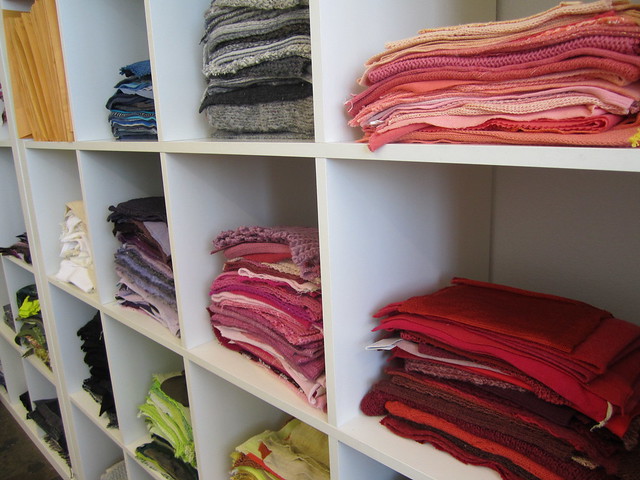
In a spacious building housing workrooms with doors that open like chambers, Elizabeth Brunner prepares a sketch for a garment as another worker cuts and sews fabrics together to make a blouse. The makeshift factory around them is filled with sewing machines, fabric rolls and scraps discarded sporadically on the floor with the other leftover fabrics.
But at San Francisco’s Piece x Piece in the Dogpatch neighborhood, nothing is mass produced and no fabric goes wasted.
“Everything here is literally made piece by piece,” Brunner, creative director and founder of the online store, said. “I have a very certain aesthetic where the pieces are timeless and seasonless.”
Piece x Piece is a sustainable fashion label that was founded by Brunner in 2008. She brings in precious fabrics and wasted resources to remake and create one-of-a-kind garments. In 2010, Piece x Piece launched its fashion line on the web, where all creations are sold exclusively.
Brunner studied interior architecture and later entered in the fashion design program at the California College of the Arts where she earned a degree in fine arts. It was there that she was inspired to reuse and recreate environmentally friendly, fashionable clothing.
By collecting fabrics that are leftover and discarded from other fashion designers, Brunner feels that she is doing her part to lessen her environmental impact on the industry.
“I grew up learning to not be wasteful and it carried on to when I got older,” Brunner said. “I wanted to do something where I can help prevent and address the issue of the waste that happens in the fashion industry.”
Reeves Sinnot is an apparel freelancer who works for Brunner, helping her with labeling, sales, fabric pick-ups and sometimes managing the online store. The two have worked together since the store opened.
“Elizabeth and I went to college together and she had a vision about starting a line that will make use out of these leftover fabrics,” said Sinnot, who went to school with Brunner three years ago. “It’s tough in this industry and the great thing about Piece x Piece is the garments are so different and timeless that you can wear them all year round.”
Piece x Piece uses donated and locally obtained fabrics. In order to make a flattering blouse or blazer, workers must find the perfect combination of fabrics and textiles to make a cohesive piece.
Once the fabric is chosen, the pattern maker must cut the fabrics in straight lines to be sewn and ironed down. The amount of work put into each garment is then reflected by its price.
“I will say that Piece x Piece is not cost affordable,” Brunner said. “There is a lot of limited edition items where manufacturing and sourcing is highly involved. Everything is handcrafted and the time to make these pieces is higher in price.”
Brunner has five contract workers currently. Michaela Montfort — a freelancer with a background in sewing, pattern making and fashion designing — contributes to Piece x Piece by crafting garments and sewing fabrics.
According to Montfort, garments have higher price points when some textiles are organic or produced in-house, but what really puts the large numbers on the price tag is the craftsmanship of sewing.
“It’s a really amazing concept for a sustainable fashion line and what we see a lot in fashion today is fast fashion where it’s cheap, trendy — and something you can pretty much throw away after a couple wears,” Montfort said in explaining that the quality of Piece x Piece garments is worth the money.
Montfort calls Piece x Piece garments investment pieces made to be fallen in love with.
Brittney Myers, apparel design and merchandising major at SF State, likes the concept of the clothing line.
“This line reuses old designs and reproduces something fresh,” Myer said. “This is a smart business and ensures that nothing goes to waste. Piece x Piece is taking this inevitable aspect of the fashion industry and uses it to their advantage.”
Despite the challenges of creating a brand and upholding a business, Brunner has turned her love for fashion into an everyday adventure.
“It’s a challenge with sustainable lines,” Brunner said. “But it’s very exciting at the same time.”






